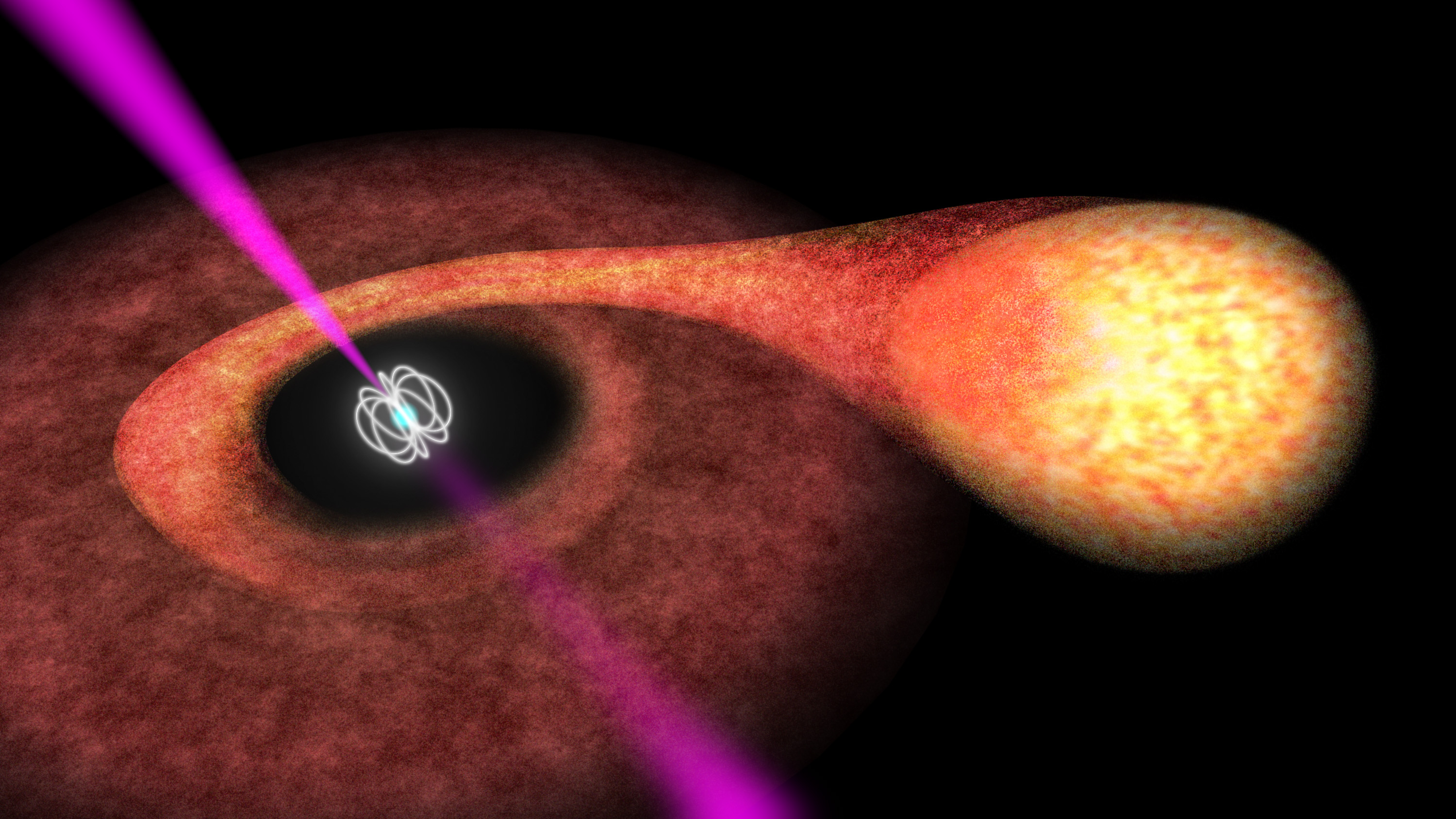Merging Neutron Stars Made An Unstoppable Jet, And It Moves At Nearly The Speed Of Light
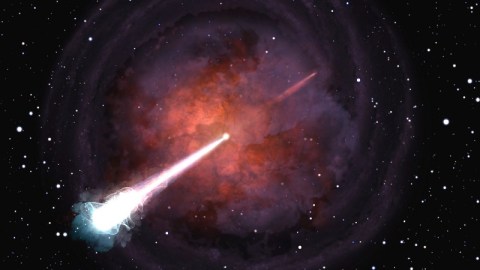
In 2017, we saw gravitational waves a neutron star merger for the first and only time. And it keeps getting more interesting.
On August 17, 2017, a cosmic signal arrived at Earth that would forever change how we viewed the Universe. Over 100 million years prior, two neutron stars bound together in the distant galaxy NGC 4993 finished inspiraling and merged together, creating a stupendous cosmic explosion when they did. The event is now known as a kilonova, and is thought to be responsible for the creation of the heaviest elements present throughout the Universe.
The inspiral and merger created two signals that we were able to detect practically simultaneously: gravitational waves, detectable with LIGO and Virgo, and electromagnetic radiation, or light, across the full suite of wavelengths we’re able to observe. But there’s something else emitted too: matter. Today, in a new paper published in Science, scientists determined that an enormous jet was produced, and it’s still moving at nearly the speed of light.
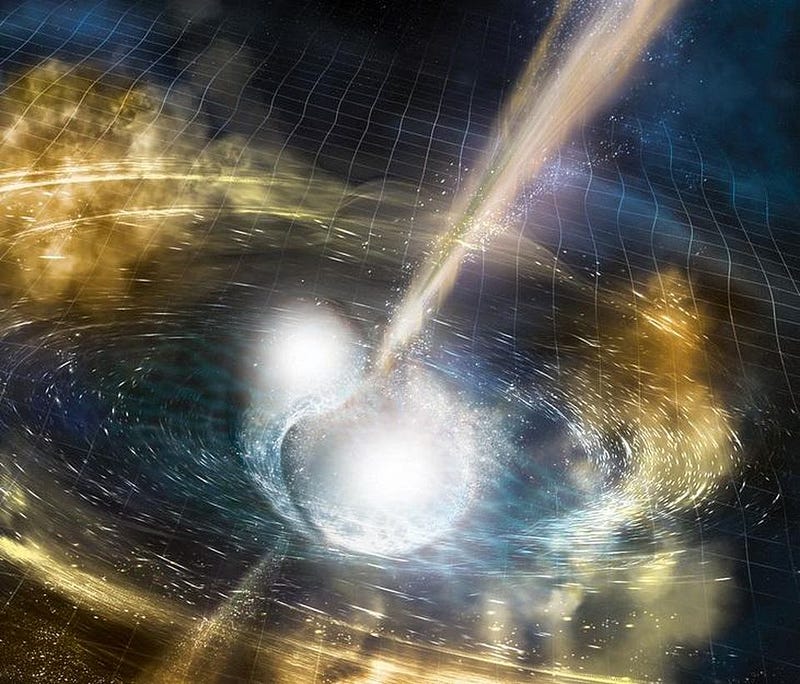
It’s not a surprise that an event like this would produce something so energetic. Neutron stars themselves are some of the most extreme objects you can imagine. Imagine taking an object as massive as the Sun or even greater, and compressing it down into a ball about the size of a major city like Chicago. It would be like one enormous atomic nucleus, where the inner 90% of it is simply a ball of solid neutrons, hence the name: neutron star.
On their own, neutron stars can spin so fast — up to about two-thirds the speed of light — that they create the largest known magnetic fields in the Universe: hundreds of millions of times as strong as any magnet on Earth, and a quadrillion times stronger than Earth’s magnetic field. As far as we know, if you were to make a neutron star any denser, it would collapse down into a black hole.
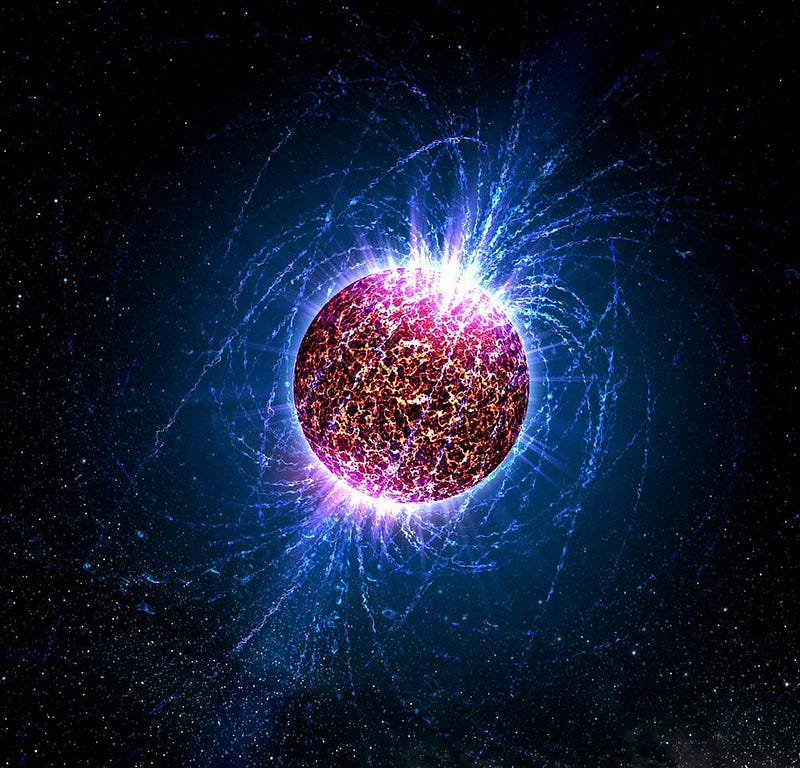
What we observed in 2017 was even more spectacular than a neutron star on its own: we observed the inspiral and merger of two of these objects. Before the merger took place, we know that two neutron stars, each a little more massive than our Sun, were locked in a binary orbit. As they moved about their mutual center of mass, they emitted gravitational waves, radiating energy away as their orbits became tighter and faster.

In the final instants, this radiation increased in both amplitude and frequency, and then they reached the most crucial moment of all: their surfaces touched. In a tiny fraction of a second, their densities increased past a critical threshold, and a runaway nuclear reaction took place where they contacted one another. All at once, an event known as a kilonova occurred.
Less than two seconds after the gravitational waves reached their strongest, a spike was seen in the electromagnetic spectrum: by NASA’s Fermi gamma-ray observatory. This event, known as a gamma-ray burst, was the first one ever correlated with a neutron star-neutron star merger.
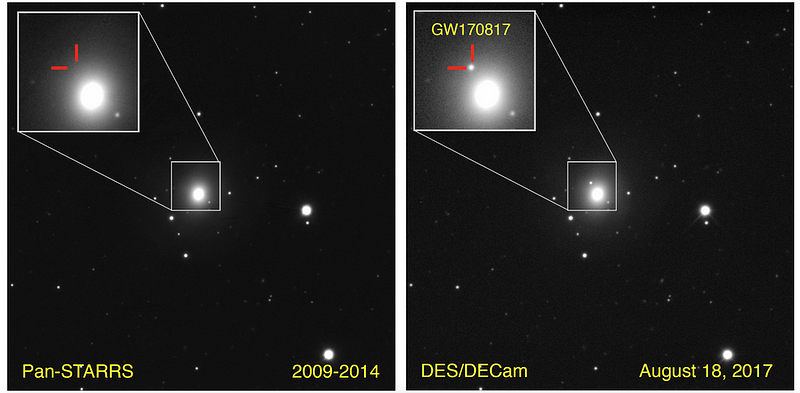
The burst may have been short-lived, both in gravitational waves and in gamma-rays, but the signals we received were spectacularly informative. Almost immediately, we learned:
- what the masses (about 1.3 Suns) and distances (about 130 million light-years) of the neutron stars were,
- what they became after the merger (a rapidly spinning neutron star that collapsed to a black hole in less than a second),
- how much of the mass became a black hole (about 95%),
- and what happened to the rest of the mass (it became the heaviest elements in the periodic table, including gold, platinum, uranium and plutonium).
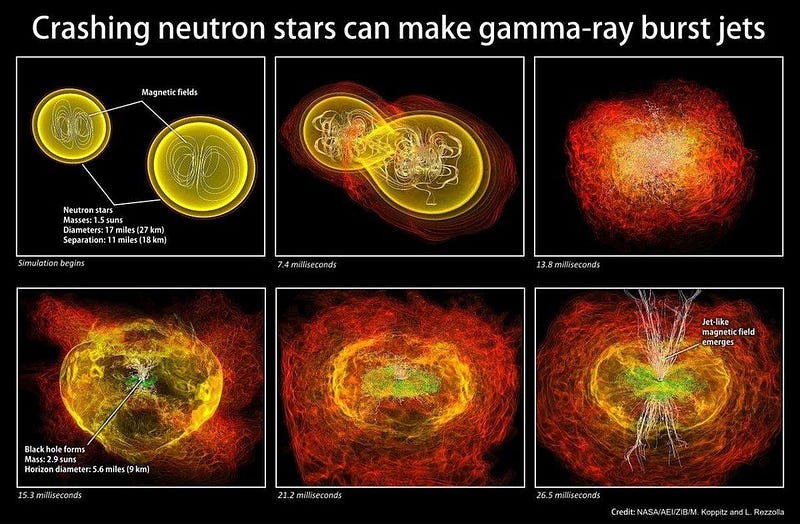
But we weren’t done yet. There was still the afterglow, which became visible to telescopes of all different wavelengths all across the world. X-ray, ultraviolet, optical, infrared and radio telescopes all viewed this first-of-its-kind event, monitoring it continuously for weeks on end. The afterglow, as we went to longer and longer wavelengths, brightened as time went on, then faded in most of the frequencies where we could look.
We were able to quantify the production of the different elements. For example, about 10⁴⁶ atoms of gold were created, or ten quadrillion times as much as we’ve mined in all of human history. We learned that the two neutron stars had their origin some 11+ billion years ago, and were inspiraling ever since, right up until the moment they merged. We learned that the majority of the heaviest elements in the Universe are made in neutron star collisions like this one.
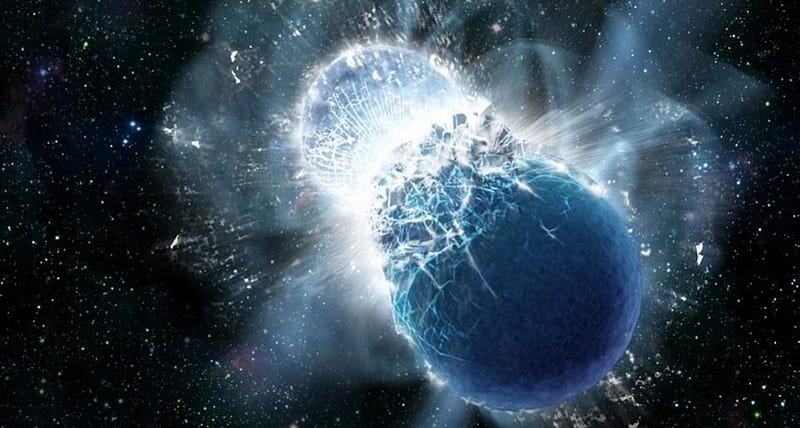
But we still weren’t done. Even though the signals were fading all across the electromagnetic spectrum, there was still more science to be done. The majority of the light was coming from radioactive decays of the material that was injected into the interstellar medium surrounding the collision point, and — as you’d expect from anything with a half-life — the majority of the decays occurred early on, and dropped off rapidly.
But then, weeks after the collision, there was a re-emergence of both X-rays and radio waves, and this enhanced new signal lasted for months. It was initially theorized that there was material ejected from the collision, and it was smashing into gas that already existed in the interstellar medium. That interaction provided an energy injection, the line of thought went, and that was responsible for the re-emergence of a glow that was previously fading away.
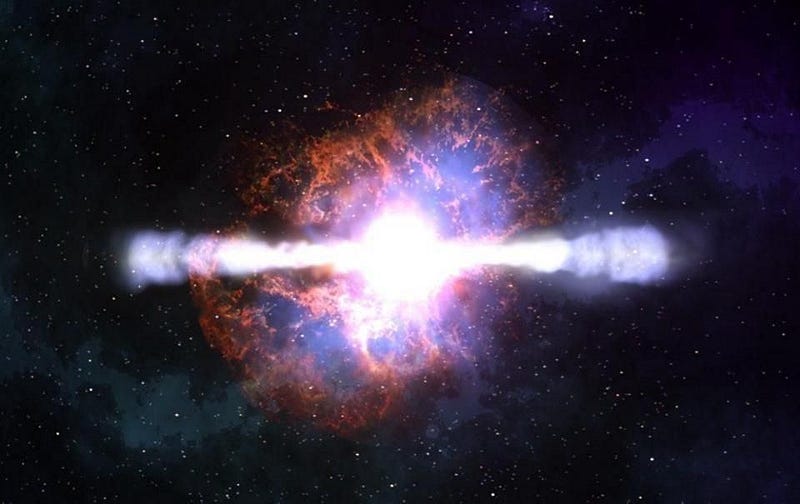
In the best instances of science, though, we don’t simply put forth a likely explanation and consider the case closed. We look for follow-up information to test our ideas out, and determine whether they hold water or not. As powerful and advanced as our best theories may be, we absolutely have to confront them with experimental or observational data, or we aren’t truly doing science at all.
The most impressive part about the new research that was just published is that it contains a fantastic suite of data. Using an array of 32 individual radio telescopes, spread over 5 continents and making simultaneous observations of the same objects, scientists were able to observe the radio afterglow as never before. By implementing the technique of very long-baseline interferometry (VLBI) with a bright source like this, they achieved unprecedented resolution.
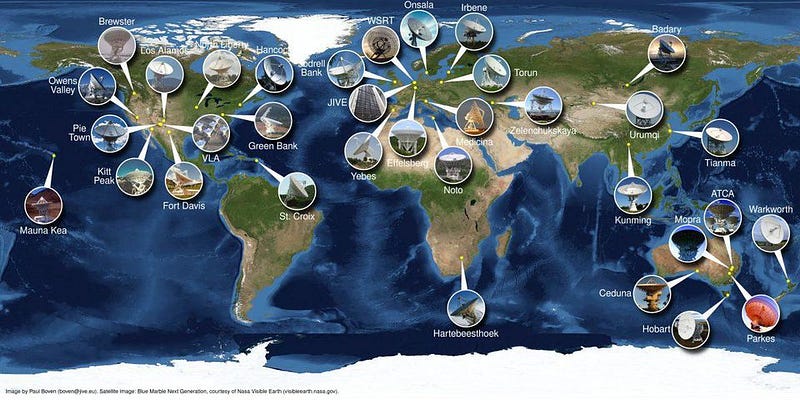
Resolution is what you need if you want to determine the shape or configuration of a distant source in the Universe. Typically, you get better resolution by building a bigger telescope, as the number of wavelengths of light that fit across it determine the angular size of what you can resolve.
But using the VLBI technique, you can do even better if your source is bright enough. Sure, you’ll only get the light-gathering power of the size of your individual dishes, but you can get the resolution of the distance between the various telescopes. This is the technique that the Event Horizon Telescope is using to construct their first image of a black hole’s event horizon, and this is the technique that enabled astronomers to determine the shape of what resulted after this neutron star-neutron star merger.
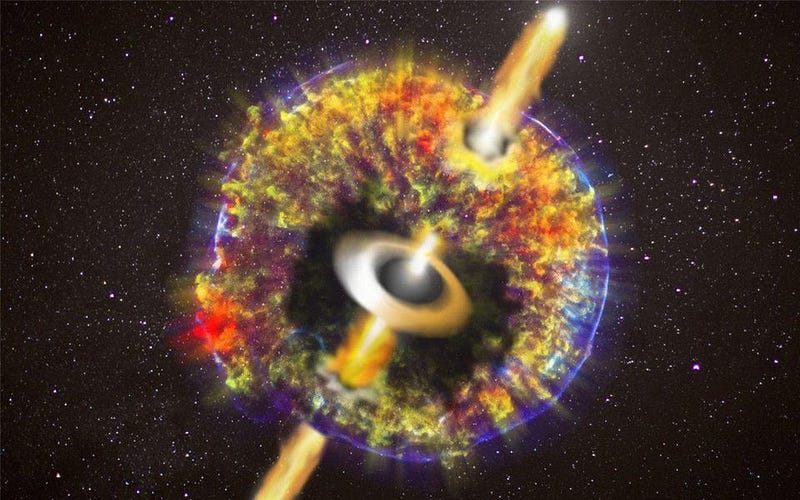
Led by Giancarlo Ghirlanda, a whopping 207 days of data was combined, allowing astronomers to see what was created over time.
The result was spectacular: the merger produced a structured jet of material, that sped away from the collision point in two anti-parallel lines. While many scientists expected that there would be some sort of cocoon-shape, or something constraining any jets that were produced, the data indicated otherwise. Instead, this structured jet punched through all the material ejected in the merger and continued to rapidly escape into interstellar space at nearly the speed of light. It was as though nothing at all could slow it down.
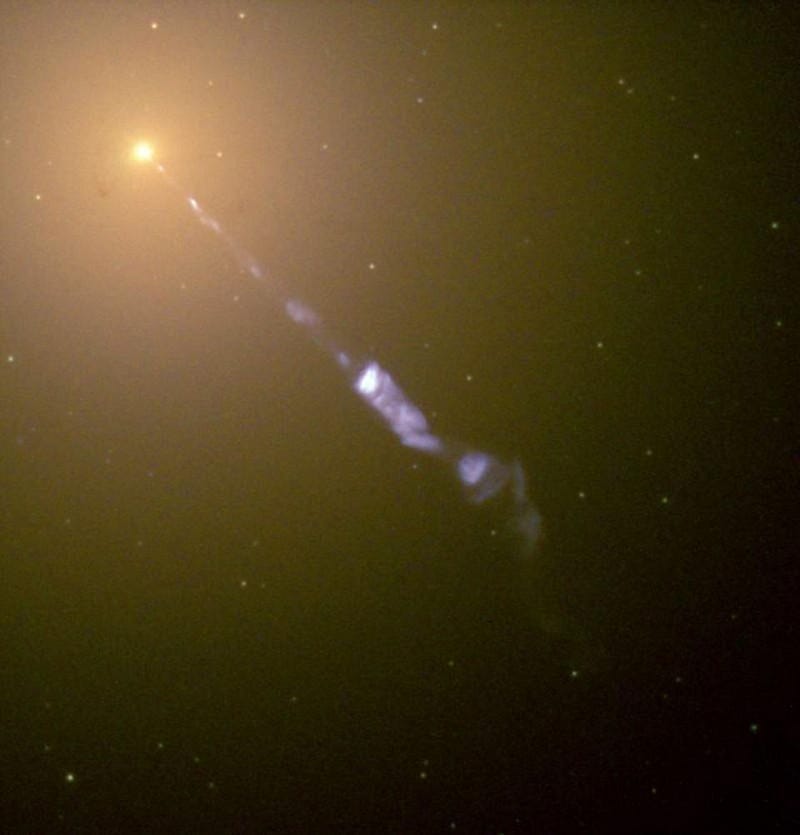
How can you make a jet like this? We’ve only ever seen them from one other source: from black holes that are feeding on matter. That must be the clue that solves the puzzle! It isn’t that the merger itself created a jet, but that the completed merger produced a black hole, and this spinning black hole accelerated the matter around it, producing the jets that we saw afterwards. It explains why there was a dimming followed by a second round of brightening, and it explains the collimated structure and the fantastically large energies and speeds. Without a central black hole, there’s no known way to do it.
This is, perhaps, the long-awaited proof that these merging neutron stars, observed in 2017, must have produced a black hole. Based on our current understanding of the Universe, we could not be more certain.
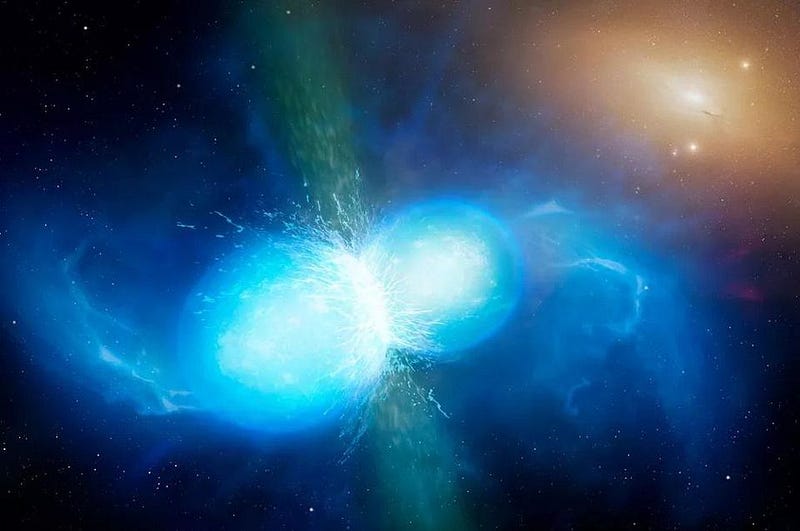
In science, sometimes the best results are the ones you weren’t expecting. We may have anticipated that merging neutron stars would create the heaviest elements of all, but no one saw a structured jet emerging from a black hole afterwards as something that should occur. Yet here we are, reaping the gifts of the Universe. It’s a reminder from the cosmos to us: the day we stop our scientific inquiries, we stop uncovering the mysteries that underlie our existence.
Ethan Siegel is the author of Beyond the Galaxy and Treknology. You can pre-order his third book, currently in development: the Encyclopaedia Cosmologica.




